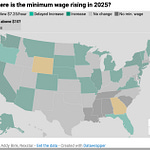
“The car, her biggest investment, became her home — the roof turned into a dining table, the trunk a closet. And a weathered stretch of blacktop provided by a Methodist church became her yard, her neighborhood and her safe place.” Note: “Her” is Chrystal Audet, a social worker with a full-time job living in her car in Kirkland, Washington, and shadowed by a New York Times reporter for this story. The New York Times, October 17, 2023
It’s called “vehicle residency”, and it’s increasing across the country. In fact, 2022 Housing and Urban Development (HUD) data show that nearly 600,000 people in the United States are homeless, and additional data confirm that nearly 40% of that number are living in a place “not suitable for human habitation [such as] city sidewalks, a vehicle, abandoned building or park” (emphasis added). According to the National Alliance to End Homelessness, a vehicle is not suitable shelter for a human.1
Yet soaring rents and a constricted home buying market in most areas of the country, combined with loss of government pandemic aid and overall food and other cost of living increases have contributed to a greater number of homeless Americans, in the last few years in particular. As expected, cities and states with the highest housing costs have a greater number of homeless, and those with significantly lower housing costs, have a correspondingly lower number of homeless. For example, cities with incredibly high housing costs like “L.A., San Francisco, New York City, Boston, Seattle and Portland have a high per capita homelessness rate, and states with low housing costs, like Mississippi and West Virginia, have exceeding low rates of homelessness despite higher levels of overall poverty than other states.
And millions of other Americans are living precariously close to losing the roof over their heads: In addition to poverty as a risk factor for homelessness, an increasing number of Americans, an estimated 7.1 million (using 2021 statistics) live with “severe housing cost burden”, defined as households spending more than 50% of their income on housing. The standard percentage to maintain financial stability is to spend no more than 30% of income on housing costs.
Although there are numerous, science-driven programs in place across the country to help reduce homelessness, the focus seems to be more of a band-aid approach, rather than an approach that prevents homelessness, like ensuring there is enough affordable housing, especially in areas with exorbitant housing costs, and helping to move people on the verge of homelessness to affordable housing before foreclosure or eviction occurs. These proactive measures can only be accomplished with programs designed to prevent homelessness before the process starts—curbing rent increases, strengthening eviction laws and providing temporary monetary assistance for renters who have lost their jobs or are working under reduced hours. There doesn’t have to be a worldwide pandemic to enact programs that keep people off the streets (and parking lots) of America.
For instance, one reaction, and it is clearly reactive, to the increasing number of homeless living in cars is to provide relatively safe, 24 hour parking lots for the homeless with vehicles to live temporarily, including some lots with security guards, portable bathrooms with running water and help to navigate a transition to permanent housing. Colorado’s Denver metro area seems to be leading the way with its “Colorado Safe Parking Initiative” that has expanded the number of its safe parking lots to 13.
In other cities, places of worship provide safe parking lots for the areas’ homeless.
On a national level, the Biden administration has recently announced a project led by the Department of Transportation to convert unused downtown office space to affordable housing. Not only does this project create more livable spaces, it does so without using the massive amount of land and other resources for new housing and locates it near existing public transportation hubs. At the same time, the commercial establishments that would follow the influx of new residents will create bustling “downtown” areas again, rather than commercial suburban sprawl that separates people’s housing from their activities.
“…the Department of Housing and Urban Development will release an updated notice detailing how its Community Development Block Grant fund can be used for projects aimed at boosting housing supply, the fact sheet stated, “including the acquisition, rehabilitation, and conversion of commercial properties to residential uses and mixed-use development.” CNN.com, October 27, 2023
The discussion we’re having in this post about our increasing homeless population, and cars doubling as shelter in the United States of America, can be misleading. It presents after-the-fact statistics documenting some of the reasons why homelessness has increased in the last few years, and what a few states and the Biden administration are doing to keep the problem of homelessness from getting worse. But what I’ve tried to show in this newsletter over the last two years is what leads people into poverty and homelessness and keeps them there.
The New York Times article quoted at the beginning of this post and written just about ten days ago, follows one particular woman, her daughter and their dog as they navigate homelessness together, including what events, turns of bad luck and maybe a few poor decisions led an educated social worker with a full-time job to not be able to afford an apartment. Granted, she lives in one of the highest priced housing markets in the country and her landlord recently raised her rent, but she also had medical debt from an illness, a low credit score and as a result, a near usury interest rate on her used car loan, the car she is now using for shelter. I’ve written about each of these issues and the politics and policy choices behind them, and how individually or combined, our current laws and policies can lead to poverty for any of us.
________________________________________________________________________________________
I’d love to hear what you think of our country’s increasing homeless population, the creative use of their vehicles for shelter, and other issues you find important. Please leave your thoughts in the Comment Section below.
Please consider supporting The Poverty Trap with a free or paid subscription. Your financial support will allow me to continue writing this newsletter and expanding it with podcast interviews and more. Thank you in advance for your financial support of my writing!
This 2023 report from “The National Alliance to End Homelessness” provides a detailed overview of both homelessness trends and the current state of homelessness in the U.S.: https://endhomelessness.org/homelessness-in-america/homelessness-statistics/state-of-homelessness/














Share this post